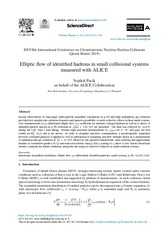Elliptic flow of identified hadrons in small collisional systems measured with ALICE
Pacík, Vojtech; Acharya, Shreyasi; Acosta, Fernando T.; Adamová, Dagmar; Adolfsson, Jonatan; Aggarwal, Madan M.; Aglieri Rinella, Gianluca; Agnello, Michelangelo; Agrawal, Neelima; Ahammed, Zubayer; Alme, Johan; Altenkaemper, Lucas; Djuvsland, Øystein; Ersdal, Magnus Rentsch; Fionda, Fiorella Maria Celeste; Nystrand, Joakim; Rehman, Attiq Ur; Røhrich, Dieter; Tambave, Ganesh Jagannath; Ullaland, Kjetil; Wagner, Boris; Zhou, Zhuo; Arsene, Ionut Cristian; Bätzing, Paul Christoph; Dordic, Olja; Lardeux, Antoine Xavier; Lindal, Svein; Mahmood, Sohail Musa; Malik, Qasim Waheed; Richter, Matthias; Røed, Ketil; Skaali, Toralf Bernhard; Tveter, Trine Spedstad; Wikne, Jon Christopher; Zhao, Chengxin; Hetland, Kristin Fanebust; Kileng, Bjarte; Nesbø, Simon Voigt; Storetvedt, Maksim Melnik; Helstrup, Håvard; Langøy, Rune; Lien, Jørgen André; Ahn, Sang Un; Aiola, Salvatore; Akindinov, Alexander; Al-Turany, Mohammad; Alam, Sk Noor; Albuquerque, D. S. D.; Aleksandrov, Dmitry; Alessandro, Bruno; ALICE, Collaboration
Peer reviewed, Journal article
Published version

Åpne
Permanent lenke
https://hdl.handle.net/1956/23222Utgivelsesdato
2019Metadata
Vis full innførselSamlinger
Originalversjon
https://doi.org/10.1016/j.nuclphysa.2018.09.020Sammendrag
Recent observations of long-range multi-particle azimuthal correlations in p–Pb and high multiplicity pp collisions provided new insights into collision dynamics and opened a possibility to study collective effects in these small systems. New measurement of pT-differential elliptic flow (v2) coefficient for inclusive charged hadrons as well as a variety of identified particle species in p–Pb collisions at √ sNN = 5.02 TeV recorded by ALICE during the LHC Run 2 data taking are presented. Besides high precision measurements of v2(pT) for π ± , K ± and p(p), the very first results for K ¯ 0 S , Λ(Λ¯ ) and φ are shown. In order to eliminate non-flow contamination, a pseudorapidity separation between correlated particles is applied as well as subtraction of remaining non-flow estimate based on a measurement of minimum-bias pp collisions at √ s = 13 TeV. Moreover, reported characteristic mass ordering and approximate NCQ and KET scaling of v2 allows to test various theoretical models, constrain the initial conditions, and probe the origin of collective behavior in small collision systems.
